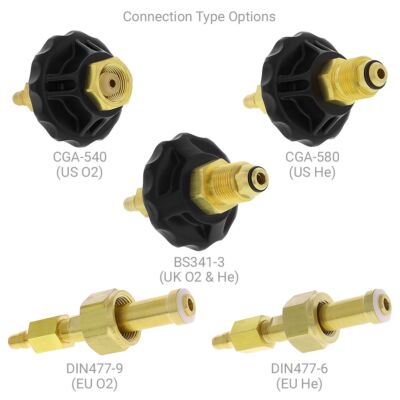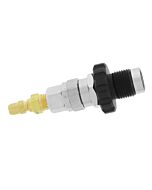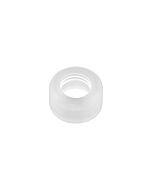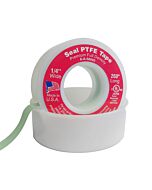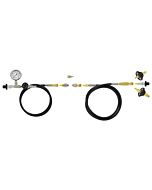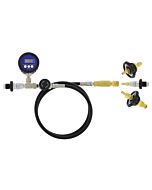Bulk Gas Storage Cylinder Valve Adapters with QD Stem
- QD Adapters for valve connectors commonly found on bulk supply Oxygen and Helium gas storage cylinders
- CGA-540 (Oxygen) and CGA-580 (Helium) for North America
- BS341-3 (aka Bullnose #3) for UK, Australia, Asia and Middle East
- DIN477-9 (Oxygen) and DIN477-6 (Helium) for most European Union countries
Bulk Gas Storage Cylinder Valve Adapters with QD Stem
The specific adapter required varies depending on local standards in the country of use, see the description below to determine the appropriate adapter for your needs.
Our booster and transfill deluxe hose kits already include the CGA adapters for North America. If you wish to use our Deluxe Fitting and Hose Booster Kit or our Deluxe Gas Blending and Transfill Kit outside North America, you may want to add one or more of the other international standard adapters.
If you are a blender who wants to maximize your supply and minimize fill times then you are cascade filling using several supply cylinders. Having additional adapters with a quick disconnect on each supply cylinder makes cascading easier by enabling the rapid movement of the supply side hose from one bottle to the next in your cascade.
Portable bulk storage cylinders have outlets that vary depending on the standard adopted in the geographic area where the cylinders are located:
- The CGA-540 (O2) standard fitting is found on portable bulk storage Oxygen gas cylinders in North America. Brass construction with a plastic handwheel, the nipple includes a special soft tip seal made from PCTFE. (The adapter does NOT fit the CGA-870 pin indexed connector typically seen on small portable medical oxygen cylinders.)
- The CGA-580 (He) standard fitting is found on portable bulk storage Helium, Argon and other inert gas cylinders in North America. Brass construction with a plastic handwheel, the sealing o-ring included on the nipple is an AS568-013.
- The BS341-3 (O2 & He) standard fitting (aka "Bullnose #3") is most commonly seen on portable bulk storage cylinders for both Oxygen and inert gases like Helium in the UK and Australia, most of Asia and Middle East, plus a handful of European countries. Brass construction with a plastic handwheel, the sealing o-ring included on the nipple is a AS568-013. (Although the BS341-3 and CGA-580 look similar, the threads are slightly different and are not compatible with each other.)
- The DIN477-9 (O2) standard fitting is most commonly seen on portable bulk storage cylinders for Oxygen in the European Union countries. All brass construction, installation requires a wrench, the sealing O-ring included on the nipple is an AS568-013.
- The DIN477-6 (He) standard fitting is most commonly seen on portable bulk storage cylinders for Helium and Argon in the European Union countries. All brass construction, installation requires a wrench, the sealing O-ring included on the nipple is an AS568-013.
| Brand | DGX |
|---|---|
| SKU | DX-701500-XXX |
| Weight | 2.000000 |
Customer Reviews
 WARNING
WARNING
Oxygen-related fires and explosions can result in serious injury or death. According to our suppliers, these products are compatible with oxygen and factory cleaned for use with oxygen. Nonetheless, the 'clean state' of this equipment applies only prior to initial use. Thereafter, periodic inspection and cleaning are a necessity.
Never breathe unblended pure inert gases such as helium or argon that do not contain oxygen, as even a few breaths can cause sudden loss of consciousness without warning. Pure inert gases are sold in compressed gas storage cylinders with a special valves designated for use ONLY with inert gases; never use ordinary diving cylinders with SCUBA valves to store unblended pure inert gas.
YOU MAY ALSO BE INTERESTED IN THE FOLLOWING PRODUCT(S)
How do the grades of compressed oxygen differ?
Nearly all compressed oxygen gas produced in the US is what is known as USP quality, meeting or exceeding United States Pharmacopeia quality standards for human consumption. The gas itself is normally manufactured using cryogenic separation of air, resulting in a gas that is very close to pure oxygen: > 99.5% with the balance being inert gases, mostly argon. There are three grades of compressed oxygen gas widely sold in returnable supply cylinders with the CGA-540 dedicated oxygen connector on the valve: Aviation (aka ABO), Medical, and Industrial (aka Welding). As a practical matter, the differences in the three grades as sold today are not quality of the oxygen being put in the cylinder but rather the procedure used to fill the cylinder and, in the case of Medical grade, licensing or documentation requirements.
Industrial grade oxygen cylinders can be just topped up when refilling and, although unlikely, could be contaminated with other unknown gases that might have back-flowed into the cylinder during use or filling. Aviation and Medical grades must have the cylinder completely evacuated before every fill with each documented and traceable lot being tested for purity. Medical grade oxygen is legally regulated in the US by the Food and Drug Administration and filling a cylinder for medical use incurs some FDA licensing requirements for the cylinder fill station operator.
Medical oxygen is considered a drug, and thus requires a doctors prescription for the FDA licensed fill station operator to fill the cylinder. The FDA has granted an exception to the prescription requirement for medical cylinders marked as emergency use only, but they still should only be filled with USP quality oxygen and following FDA guidelines. To blend breathing gas mixtures for Nitrox and technical diving, most blenders use Aviation grade oxygen to avoid the FDA licensing requirements yet still use an oxygen grade suitable for human consumption.
Among divers, perhaps the most often debated topic about oxygen grades is should industrial grade oxygen be used for SCUBA applications. That's because welding oxygen is relatively cheap and brand name compressed gas suppliers usually fill oxygen cylinders from the same high quality source while following best practices regardless of grade. However, small welding supply operations are more likely to just top up their industrial grade oxygen cylinders from a local bulk supply and may not follow best practices. Unless the entire supply chain for each and every cylinder of oxygen can be trusted with absolute certainty, in our opinion using industrial grade oxygen for diving applications is a needless risk.
